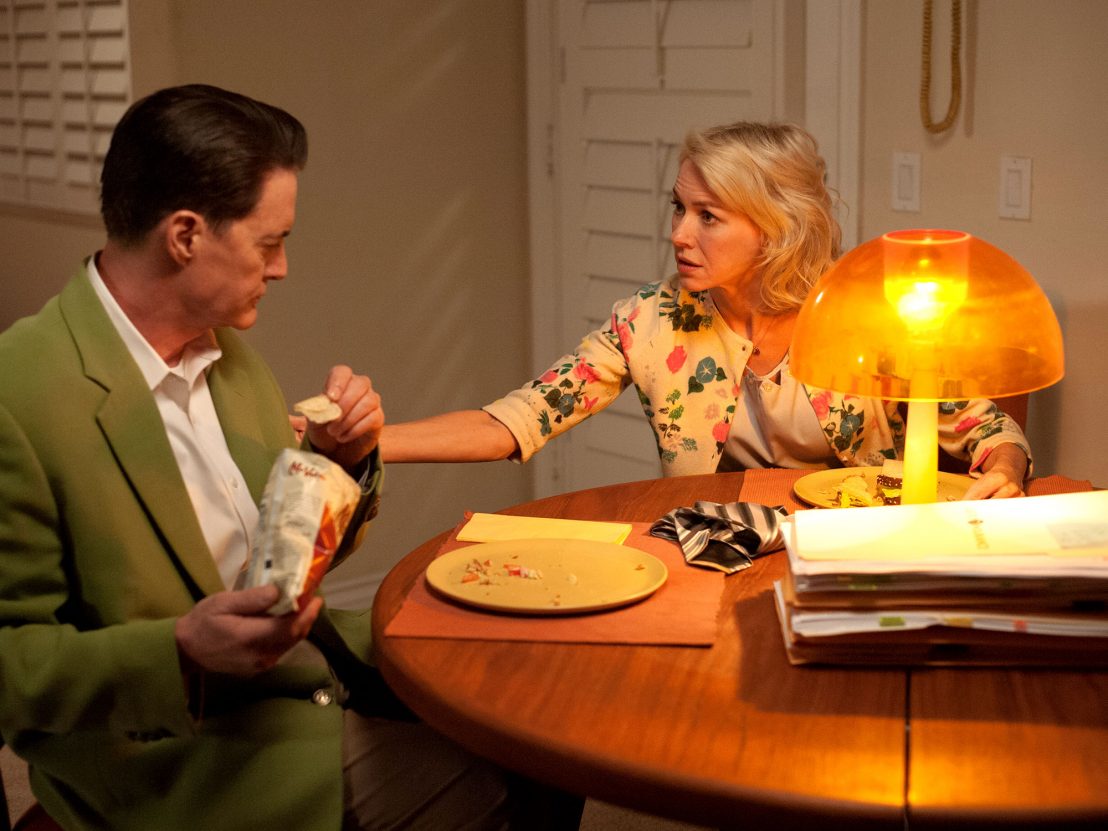
This article contains spoilers for Twin Peaks season 3 part 6. For maximum enjoyment, we recommend reading after you’ve watched the show.
In the pilot episode of Twin Peaks, Agent Cooper examines Laura Palmer’s body. While filming the scene, the set was beset by a faulty florescent light, causing it to flicker uncontrollably. Instead of getting annoyed and calling for it to be fixed, David Lynch reacted by manning the switch himself, lending the whole sequence a quintessential weirdness and, given what we now know about the function of electricity in the show, a certain eeriness. Indeed, we can look to this happy accident as the reason for electricity becoming a key motif throughout the series.
It’s in Twin Peaks: Fire Walk with Me, where electricity began to really make its cryptic presence better known. The opening shot, a slow zoom out that reveals a blue-hued television screen, has always been regarded as something of an in-joke, climaxing as it does with Leland Palmer smashing the TV set with a piece of wood.
We see amorphous, blurred shapes shift and dance across the screen. Call it a mood-setter, call it an amusingly violent response to the show’s cancellation after season two, but this shot offers up the supernatural universe of Twin Peaks as if under a microscope; atomised, reduced to its barest and most vital component, the one that arguably governs all.
Elsewhere in the 1992 prequel film, we see the Man from Another Place (in season three he’s an electrical tree with a lumpy piece of flesh atop it) declaring “E-LEC-TRICI-TY!” during the convenience store flashback. (Intriguingly, the snowy effect momentarily reappears over the shot of the Dancing Man and the Man from Another Place, linking electricity directly to the lodge spirits and explicitly referring to the opening shot.)
In Hap’s Diner, as Agents Chet Desmond and Sam Stanley drink their damn fine coffee and question Irene about Teresa Banks, there’s a guy in the background fixing a lamp; again the wild flickering lends the scene a surreal and unsettling quality. Then there’s the telephone pole outside Deer Meadow’s Fat Trout trailer park (seen again in season three, part six), which appears to emit the same noise as the Arm’s Native American war-cry whooping, heavily suggesting their destructive influence may spread and travel via electricity.
In season three, electricity allows Coop a reprieve from his Black Lodge prison. Setting off via the glass cube and then a metal box floating in time and space, he is returned to the ‘real world’. Several levers had to be pulled first, juicing up the mystical – but also literal – circuitry as he is squeezed through a plug socket, emerging in Las Vegas and assuming the identity of Dougie Jones.
Twin Peaks scholar Lindsay Hallam has sagely noted electricity is the show’s predominant binding force, connecting or reconnecting everything – including Fire Walk with Me’s opening shot. Electricity also fits in with Lynch’s obsession with duality: light and dark, good and evil, doppelgängers, happiness and sorrow, surface appearance and the murky underneath. Electricity delivers illumination but equally threat and danger. When electricity falters, too, darkness and strange events commence. Twin Peaks fluctuates like the florescent light in the morgue between such dualistic tensions and realities.
In part six, Lynch again hints at the sub-textual meanings of electricity. First with the shot of the Fat Trout trailer park telephone pole and then with the ‘Sparkwood and 21’ traffic light (the most melancholic stop-go sign in the world), which for the first time appears to crackle with electronic dissonance. Lynch is telling it to us straight: bad things are afoot again in the mountain town of Twin Peaks and nearby Deer Meadow.
Published 13 Jun 2017

This mystery code word takes on a new meaning in the show’s latest episodes.

The cult director recalls a defining moment in his career in this exclusive clip from The Art Life.

Is this mysterious device Agent Cooper’s ticket into the real world?